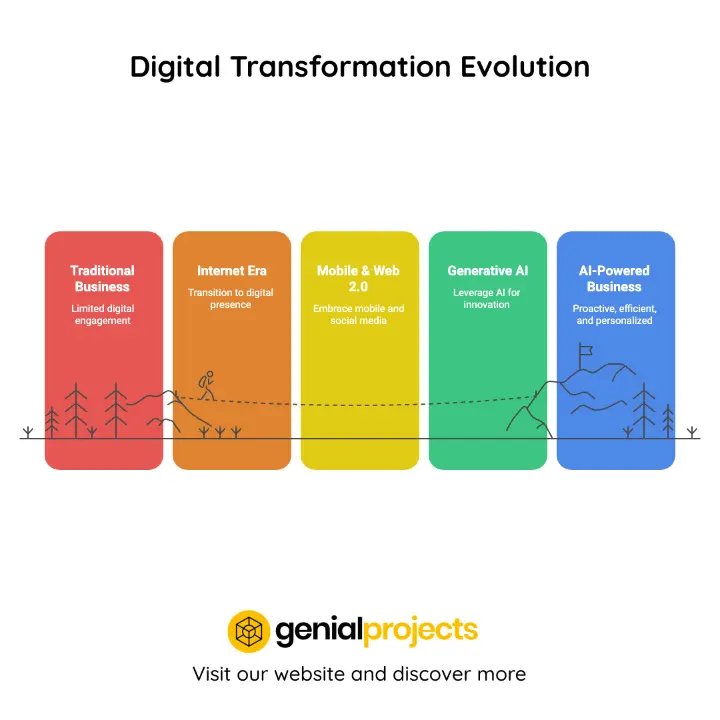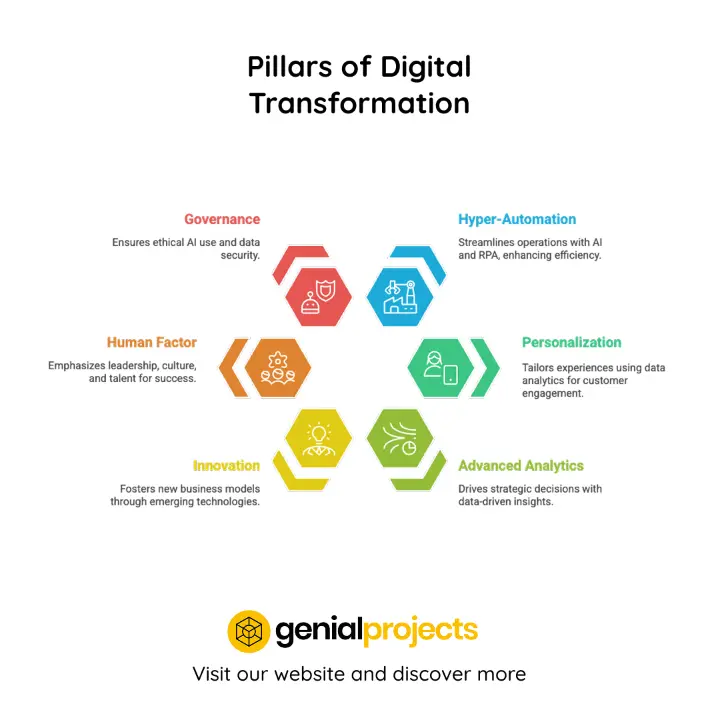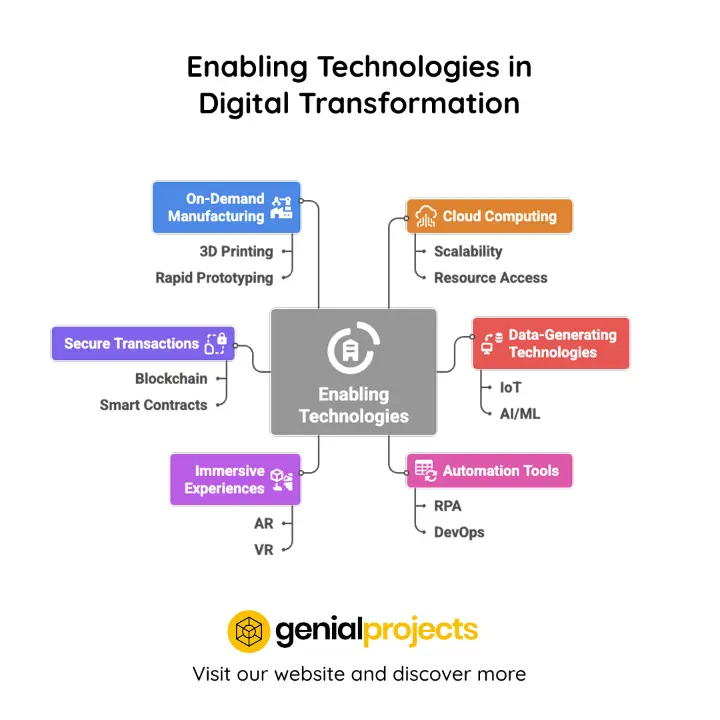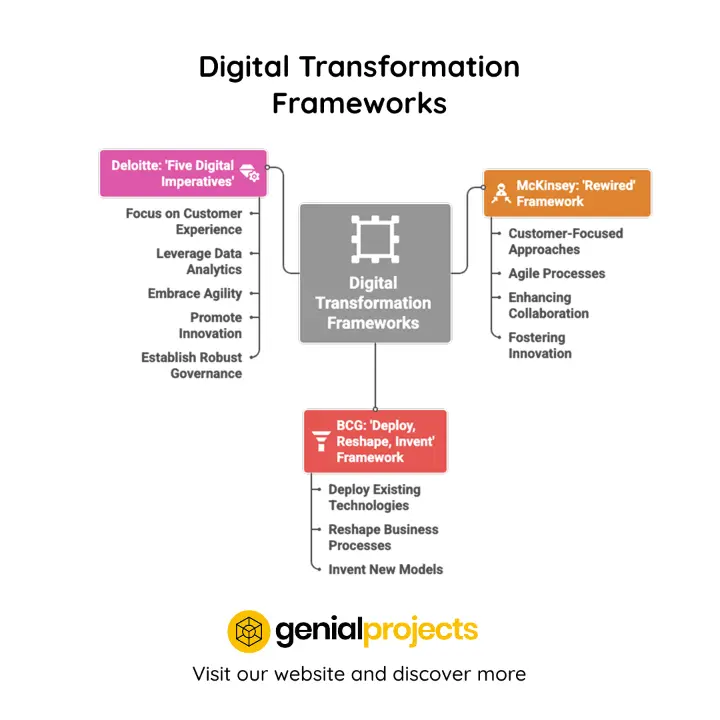In today's rapidly evolving business landscape, digital transformation has become essential for organizations striving to maintain a competitive edge. The integration of artificial intelligence (AI) technologies represents a critical juncture in this transformation, offering unprecedented opportunities to reimagine strategies, processes, and customer engagements. As we explore the evolving relationship between digital transformation and AI, it is vital to understand how businesses can harness these advancements to drive innovation, efficiency, and growth.
This article delves into the various phases of digital transformation, tracing its historical evolution, and pinpointing the current trend of generative AI. We will outline key milestones, core pillars that define successful transformations, enabling technologies, and established frameworks. Additionally, we will provide a structured approach developed by Genialprojects to facilitate robust digital transformation initiatives. By equipping decision-makers with these insights, we aim to inspire and guide them on their unique journeys toward innovation-driven success.
The Evolution of a Revolution
The journey of digital transformation has traversed multiple eras, each characterized by distinct technological innovations and shifts in consumer behavior. Understanding these phases helps contextualize today's AI landscape, illustrating how past achievements and challenges have shaped current opportunities. The consistent thread throughout each era is the persistent drive for efficiency, connectivity, and personalization, which continues to influence how businesses operate.
Era of Internet (1990-2006)
The dawn of the Internet fundamentally changed how businesses interacted with consumers and each other. This era marked the transition from traditional business models to digital engagement, enabling unprecedented access to information and communication. Businesses began to recognize the potential for online presence, which laid the groundwork for e-commerce, online marketing, and data-driven decision-making. Companies that adapted quickly benefitted immensely, capitalizing on new channels for outreach and customer acquisition.
During this initial phase, the innovations in web design, search engines, and online transactions sparked a wave of entrepreneurial endeavors. The proliferation of websites and the establishment of digital forums enabled consumers to engage with brands like never before. However, those who resisted or lagged in adopting these technologies faltered, highlighting the importance of staying ahead in adapting to technological advancements.
Mobile and Web 2.0 Era (2007-2019)
With the advent of smartphones and the rise of social media, the period from 2007 to 2019 introduced profound changes in consumer behavior and business-customer interactions. Mobile technology reshaped accessibility, allowing users to engage with brands at any time and from virtually anywhere. Meanwhile, Web 2.0 paved the way for user-generated content and rich online communities, transforming how businesses market their products and services.
Organizations that recognized and embraced this mobile and participatory culture swiftly adjusted their strategies to incorporate social media marketing, mobile apps, and personalized online experiences. This shift not only enhanced customer engagement but also facilitated the collection of user data, providing businesses with valuable insights into preferences and behaviors. However, companies that failed to adapt faced challenges in retaining customer loyalty in an increasingly competitive digital marketplace.
The Generative AI Inflection Point (2022-Present)
Today, we stand at the threshold of a transformative moment shaped by generative AI technologies. This era has seen the emergence of innovative applications that enhance creativity and streamline business processes, allowing organizations to leverage AI as a partner in decision-making, content creation, and problem-solving. Companies across various industries are beginning to see the potential of AI-driven insights, which foster a deeper understanding of their operations and customer needs.
The proliferation of generative AI represents an opportunity for organizations to transition from being reactive to proactive in their strategies. Businesses are now able to harness the power of advanced algorithms to automate routine tasks, generate personalized content, and develop predictive models that enhance decision-making. Such advancements promise not just efficiency gains but also a reimagining of business models and service delivery, fundamentally altering competitive dynamics across sectors.

Key Milestones of Digital Transformation
To grasp the significance of digital transformation, it is essential to recognize the key milestones that have influenced its trajectory. The following table summarizes critical achievements in this evolution, outlining their dates, descriptions, and impacts on businesses.
Milestone | Date | Description | Impact on Transformation |
Introduction of the Internet | 1991 | Launch of the World Wide Web marked the beginning of online connectivity. | Enabled businesses to reach global audiences. |
Rise of E-commerce | Late 1990s | Proliferation of online shopping platforms transformed retail. | Created new revenue streams and customer engagement modes. |
Emergence of Social Media | 2004 | Platforms like Facebook revolutionized consumer communication and marketing. | Changed brand-consumer relationships significantly. |
Mobile Technology Adoption | 2007 | Launch of the iPhone initiated the mobile revolution. | Shifted consumer interactions to mobile-first experiences. |
Generative AI Breakthroughs | 2022 | Advancements in machine learning allowed AI-generated content creation. | Redefined creativity and operational efficiency. |
Current Pillars of Digital Transformation
The pillars of digital transformation are integral elements that establish the framework for successful initiatives. Recognizing and understanding these pillars empowers organizations to focus their efforts effectively, ensuring that their strategies are well-rounded and impactful.
Hyper-Automation and Operational Efficiency
Hyper-automation signifies the combination of multiple automation tools, systematically enhancing productivity and efficiency across business operations. By integrating robotic process automation (RPA) with AI and machine learning, organizations can streamline manual processes, reduce operational costs, and enable staff to focus on higher-value tasks. This automation evolution presents an opportunity for continuous improvement as workflows become more intelligent and less reliant on human intervention.
To illustrate this, companies like Siemens have successfully implemented hyper-automation initiatives, resulting in lower operational expenditures and improved service delivery. Such examples highlight the tangible benefits of adopting these technologies, which ultimately culminate in more agile organizations prepared for future challenges.
Experience and Personalization at Scale
As consumers demand more tailored experiences, organizations must prioritize personalization at scale. Utilizing advanced data analytics, businesses can derive insights into customer preferences and behavior, allowing for highly personalized marketing strategies that resonate with individual consumers. By employing AI-driven recommendation engines and customer segmentation, organizations can systematically enhance user experiences.
Take Netflix, for example—its algorithm-driven recommendations have redefined how content is consumed, leading to increased viewer engagement. Organizations can replicate these strategies across various sectors by leveraging data analytics to design personalized customer journeys, thereby firmly establishing competitive advantages.
Advanced Analytics and Strategic Decision-Making
The importance of data in decision-making cannot be understated, as organizations harness advanced analytics to derive actionable insights from vast datasets. This sophisticated analysis empowers executives to make informed strategic decisions, minimizing risk while maximizing potential for growth and innovation. By employing predictive analytics and machine learning techniques, companies gain the capability to forecast trends, optimize operations, and tailor offerings to meet evolving consumer needs.
Moreover, companies like Amazon have demonstrated the power of advanced analytics in optimizing inventory management and enhancing supply chain efficiency. Organizations that embrace this data-centric approach can strategically position themselves, augmenting their agility and responsiveness to market demands.
Innovation and Creation of New Business Models
Digital transformation fosters an environment ripe for innovation, empowering organizations to explore and implement new business models that leverage emerging technologies. The dynamic landscape compels businesses to rethink traditional paradigms while embracing agility and adaptability as core tenets. As innovations emerge, businesses can experiment with various operational formats, potentially arriving at hybrid models that enhance both customer experiences and profitability
For instance, companies like Spotify and Airbnb have successfully disrupted traditional industries by implementing innovative business models that capitalize on digital platforms and user engagement. By continuously innovating and exploring new avenues, organizations can chart pathways toward sustainable growth and resilience in an ever-evolving marketplace.
The Human Factor: Leadership, Culture, and Talent
At the heart of digital transformation lies the human factor—leadership, culture, and talent—all of which play a pivotal role in driving successful initiatives. Organizational culture must champion innovation, offering a conducive environment for experimentation and learning. Empowering employees to embrace change while fostering collaboration across departments can significantly facilitate a successful transformation journey.
Additionally, effective leadership is essential to articulate a clear vision for digital initiatives, ensuring that all employees are onboard and aligned with organizational goals. Engaging talent at all levels promotes a comprehensive understanding of digital tools and fosters a culture of continuous learning, ultimately strengthening the collective capabilities of the organization.
Governance, Ethics, and Cybersecurity
As organizations harness the power of digital transformation, ensuring robust governance frameworks becomes increasingly critical. Effective governance is vital for navigating ethical considerations surrounding AI implementations, ensuring that decisions are made transparently and responsibly. Establishing a clear framework for data usage, privacy, and compliance safeguards the organization from potential risks associated with data breaches and misuse.
Moreover, the growing threat of cybersecurity attacks underscores the necessity of developing stringent protocols and protecting digital assets. By prioritizing both ethical considerations and security measures, organizations can foster trust with customers and stakeholders, establishing long-term relationships vital for sustainable success.

Enabling Technologies: The Engine of Modern Transformation
Digital transformation in the AI era is no longer driven by a single technology, but by the powerful convergence of a suite of enabling technologies. These innovations provide the essential foundation for organizations to achieve unprecedented levels of efficiency, agility, and customer-centricity. Cloud computing acts as the central nervous system, providing the scalable infrastructure, while data-generating technologies like IoT feed into AI and ML algorithms to create intelligent, predictive insights. This powerful data is then acted upon by automation tools like RPA and leveraged through modern practices like DevOps to accelerate delivery. Furthermore, immersive experiences via AR and VR, secure transactions through Blockchain, and on-demand manufacturing with 3D Printing are redefining entire business models. Ultimately, the synergy of these technologies empowers businesses to optimize operations, unlock new value streams, and secure a competitive advantage in a rapidly evolving digital landscape.
Here is a list of definitions regarding these technologies and practices:
* Artificial Intelligence (AI): The simulation of human intelligence processes by machines, especially computer systems. These processes include learning, reasoning, and self-correction. AI is the broad discipline that enables machines to perform cognitive tasks.
* Machine Learning (ML): A subset of AI that focuses on developing systems that can learn from data, identify patterns, and make decisions with minimal human intervention. It is the key engine for predictive analytics and intelligent automation.
* Blockchain: A distributed, immutable digital ledger that records transactions securely and transparently. It facilitates verifiable and tamper-proof processes, ideal for supply chains, smart contracts, and financial transactions.
* Internet of Things (IoT): The network of interconnected physical devices (e.g., sensors, vehicles, appliances) that collect and exchange data in real-time. It enables the remote monitoring, control, and optimization of operations and assets.
* Robotic Process Automation (RPA): The use of "software robots" or bots to automate high-volume, repetitive, rule-based tasks traditionally performed by humans. It interacts with digital systems to execute processes like data entry and transaction processing.
* Cloud Computing: The delivery of computing services (servers, storage, databases, networking, software) over the Internet. It offers flexible scalability, economies of scale, and on-demand access to resources without managing physical infrastructure.
* DevOps: A culture and set of practices that aims to shorten the software development lifecycle and provide continuous delivery with high quality. It bridges software development (Dev) and IT operations (Ops) to accelerate innovation and improve collaboration.
* Digital Marketing: Encompasses all marketing strategies that use online electronic channels and devices. It includes SEO/SEM, social media marketing, email marketing, and web data analytics to reach and connect with audiences more effectively and measurably.
* Virtual Reality (VR): Technology that creates a completely simulated, immersive digital environment that replaces the user's reality, typically experienced through a headset. It is used for training, virtual prototyping, and immersive customer experiences.
* Augmented Reality (AR): Technology that overlays digital information (images, sounds, text) onto the user's real-world view, usually through devices like smartphones or smart glasses. It enhances how users interact with their real environment and is useful in retail, maintenance, and logistics.
* 3D Printing (Additive Manufacturing): A process of creating a physical three-dimensional object from a digital design by adding material layer by layer. It enables rapid prototyping, mass customization, and on-demand production, revolutionizing manufacturing and design.

Frameworks for Digital Transformation Initiatives
Various frameworks provide structured guidance for organizations embarking on digital transformation initiatives. By following these established methods, businesses can navigate complexity more effectively while maximizing their chances for sustainable growth.
McKinsey: The 'Rewired' Framework
The McKinsey 'Rewired' framework emphasizes the need for a complete organizational overhaul to achieve successful digital transformation. Key components include customer-focused approaches, agile processes, enhancing collaboration, and fostering innovation. This holistic perspective encourages businesses to reconfigure their structures and adapt mindsets to embrace digital.
BCG: The 'Deploy, Reshape, Invent' Framework
The BCG framework encourages organizations to deploy existing technologies efficiently, reshape business processes, and invent new models. This method facilitates the systematic identification of opportunities while ensuring that ongoing processes are continuously optimized to reflect changes in the marketplace.
Deloitte: The 'Five Digital Imperatives'
Deloitte outlines five critical imperatives businesses must address to navigate transformation: focus on customer experience, leverage data analytics, embrace agility, promote innovation, and establish a robust governance framework. This approach ensures a comprehensive perspective on transformation, weaving together various critical aspects that drive success.

The Genialprojects Digital Transformation Framework
At Genialprojects, we have crafted a tailored approach to digital transformation that prioritizes structured assessment, integration, and governance of digital initiatives. Our framework is designed to facilitate a thorough understanding of an organization’s current digital maturity while outlining a roadmap for successful transformation.
Phase 1: Foundation Diagnosis (Metrics and Maturity)
The first phase focuses on assessing an organization’s current digital maturity. This diagnostic phase is essential for identifying strengths, weaknesses, and areas that require improvement. By engaging in activities such as digital maturity audits and mapping potential use cases for AI, organizations can gain valuable insights that guide informed decision-making.
Our objective is to establish a lasting foundation by defining key performance indicators (KPIs) and return on investment (ROI) metrics, allowing organizations to track their progress and success comprehensively.
Phase 2: Intelligent Integration (Pilot Implementation)
In the second phase, we emphasize the importance of agile pilot implementations that allow organizations to test and refine their digital initiatives. This iterative approach promotes adaptive change management, ensuring that human factors are prioritized throughout the integration process.
By leveraging continuous monitoring and adjustments, businesses can nurture a sense of collaboration while optimizing digital solutions. Our goal is to create a seamless integration process, ensuring that stakeholders remain engaged and adequately informed about the transformation journey.
Phase 3: Synergy and Scale (Governance and Culture)
The final phase of our framework focuses on maintaining effective governance structures and fostering a culture of innovation that encourages continuous improvement. The establishment of an AI governance framework aligned with organizational goals is key to sustaining momentum and achieving long-term success.
Creating a culture that champions innovation and collaboration is critical as organizations scale their digital initiatives. By integrating innovative models into the operational framework, businesses can ensure cohesion and alignment across departments, ultimately enhancing their overall effectiveness in the digital landscape.
As organizations navigate the complex terrain of digital transformation, embracing AI technologies and innovative frameworks will be vital to their success. By focusing on core pillars, supported by enabling technologies, and guided by structured frameworks, they can create robust strategies that not only adapt to the changing landscape but also drive lasting value.

Free Organizational Digital Maturity Self-Assessment
Key Takeaways
Digital transformation in the age of AI presents an unparalleled opportunity to unlock growth and innovation potential. Organizations must recognize the importance of adaptability, leveraging enabling technologies while prioritizing human factors. By committing to structured frameworks and fostering a culture of continuous improvement, businesses can navigate this evolving landscape with confidence.
In today's digital era, those who embrace change and effectively harness AI capabilities will undoubtedly lead their industries, shaping the future of business. The journey may be complex, but the rewards are worth the investment.